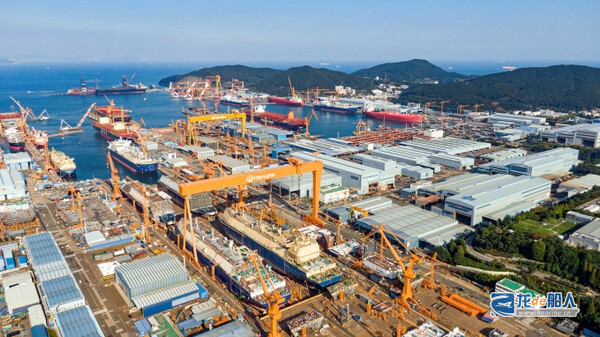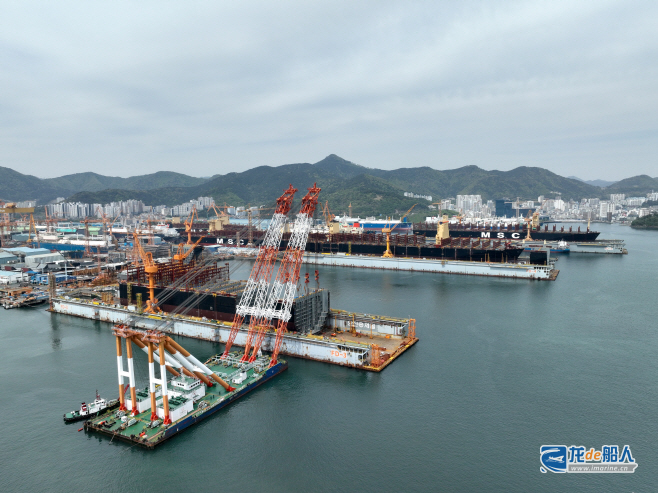Hanwha Ocean stated that the order- selection strategy it has been pursuing has shown results and is gradually improving profitability as shipbuilding momentum has been strengthened with liquefied natural gas (LNG) carriers at its core. The shipbuilder plans to spend 600 billion won to expand its production capacity.

Recently, Hanwha Ocean released through an announcement that the company’s consolidated revenue for the first quarter of this year reached KRW 3.1431 trillion (about US$2.249 billion), a year-on-year increase of 37.6 percent, and realized an operating profit of KRW 258.6 billion (about US$185 million), a year-on-year increase of 388.8 percent. This data was higher than the expected operating income of 3.07 trillion won and operating profit of 160 billion won.
The merchant ship business accounted for approximately 82% of Hanwha Ocean’s total revenue in the first quarter, based on the increased proportion of LNG carrier sales and improved product mix. During the reporting period, Hanwha Ocean’s merchant ship sector realized an operating profit of KRW 233.3 billion ( about US$167 million), which, together with a one-time profit of about KRW 30.0 billion (about US$21 million) due to exchange rate appreciation, resulted in a significant improvement in operating profit.
Thanks to the increase in submarine orders, Hanwha Ocean’s special ship business had a slightly improved quarterly performance, achieving operating revenue of KRW 303.4 billion (about US$217 million) and operating profit of KRW 41.3 billion (about US$30 million). Hanwha Ocean is expected to deliver three new submarines and complete some ship repair business this year, and expects to further improve profitability through the U.S. Navy MRO business.
In the offshore sector, its operating income declined to KRW231.9 billion (US$166 million) and profit margins narrowed due to the impact of the closing of some projects. However, Hanwha Ocean is working to recover its performance in the offshore sector in the second half of the year by strengthening process management and improving its order book.
The global merchant ship market is uncertain due to geopolitical risks and the China-US trade conflict, but the growth in demand for liquefied natural gas and crude oil transportation is a positive factor. In particular, the resumption of US liquefied natural gas projects is expected to gradually expand the demand for LNG carriers in the second half of the year.
In the first quarter of this year alone, Hanwha Ocean has received orders for 11 new ships valued at about US$2.5 billion, including two LNG carriers, three VLCCs and six ultra-large container ships. Hanwha Ocean claims that the company is expected to “benefit from the expansion of US energy projects and the restrictions on Chinese shipbuilding caused by the China-US trade conflict” in the future. In addition, Hanwha Ocean is planning to expand its US Navy MRO business and plans to actively strive for 5-6 ship MRO orders this year.

After achieving an “unexpected profit” in the first quarter of this year, Hanwha Ocean announced that it is spending about KRW 600 billion (US$429 million) to improve shipbuilding efficiency to further enhance its global competitiveness, including the construction of a new floating dock and a 6,500-ton super-large offshore crane.
Specifically, Hanwha Ocean announced that it will build a new floating dock by the end of March 2027. The new floating dock will be 480 meters long and 97 meters wide, with a floating capacity of 180,000 tons. It will increase its shipbuilding capacity when it is completed and put into operation. Currently, Hanwha Ocean has a total of five docks, including two dry docks and three floating docks.
In addition, Hanwha Ocean will introduce a 6,500-ton ultra-large offshore crane, which is expected to be delivered by the end of November 2027 and put into production. This offshore crane can directly lift and load large modules, which can simplify the complex operation of the existing two 3,600-ton offshore cranes for joint lifting.


